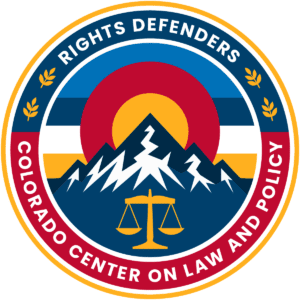CCLP's latest issue brief analyses the implications of the U.S. Supreme Court’s decision to overturn the Chevron doctrine, in conjunction with the related Corner Post decision, and current actions by the second Trump administration.
Recent articles
CCLP testifies in support of protections against junk fees
Chris Nelson provided testimony in support of House Bill 25-1090, Protections Against Deceptive Pricing Practices. CCLP is in support of HB25-1090.
CCLP testifies in support of language access in Colorado
Morgan Turner provided testimony in support of House Bill 25-1153, Statewide Government Language Access Assessment. CCLP is in support of HB25-1153, and it is one of our priority bills.
Press release: New CCLP analysis challenges claims of mass restaurant closures in Denver
A new issue brief examines recent trends in Denver’s restaurant industry and challenges claims that the city’s rising minimum wage is responsible for a significant decline in the number of restaurants.
Legislative Update: March 29, 2019

Bill levels the playing field for mobile-home owners
Manufactured or mobile homes are an affordable – if scarce – alternative for Coloradans living on the lower end of the pay scale. Approximately 100,000 Coloradans reside in manufactured housing communities. Unfortunately, people who live in these communities are too often subjected to whims of landowners who overbill for water and other utilities, increase fees to homeowners without explanations and fail to maintain the property.
Under current state law, a mobile-home owner only has two days’ notice to remove or sell a mobile home from a property following an eviction. While manufactured homes are inexpensive compared to conventional housing, removing a unit can cost thousands of dollars — not to mention that it’s a difficult ordeal to resolve in just two days.
In a 2018 review of manufactured housing communities, Colorado’s Department of Regulatory Affairs (DORA) stated that residents of these communities are being harmed by “lack of enforcement of existing laws, bad actors exploiting a relatively loose regulatory structure and the inevitable tension that arises when the house belongs to one person but the land beneath it belongs to someone else.” DORA recommended increasing enforcement options to induce compliance with the Mobile Home Park Act.
To ensure that residents of these communities can live in safe, stable environments and get fair treatment and adequate notice from landowners, CCLP is helping to develop legislation that will revise Colorado’s Mobile Home Park Act. Expected to be introduced soon, the bill would give the Department of Local Affairs’ Division of Housing the authority to administer a dispute resolution and enforcement program funded by a small lot fee on mobile-home park owners. The legislation would also extend the length of time a homeowner has to sell or move their home following eviction from 48 hours to 60 days.
To support the bill, contact Jack Regenbogen at jregenbogen@copolicy.org.
Bill to Watch: HB 1275
More than 1.8 million people are listed on the state’s criminal-record database. Unfortunately, even one non-violent misdemeanor or felony conviction from years ago could hamper Coloradans’ employment prospects and earning potential. For many Coloradans, a brush with the law could essentially lead to an “extended sentence” of unemployment, housing insecurity and an increase risk of recidivism.
Developed with help from CCLP, House Bill 1275 would make records for most non-violent convictions eligible for sealing and unavailable to the public. The bill would reduce the timeframe that a person must wait before their record is eligible for sealing. The bill would also help automate the sealing of arrests that are dismissed. If passed, the legislation would remove a barrier for many Coloradans seeking employment and housing and let them get on with their lives.
Introduced on Tuesday, the bill is sponsored by Rep. Mike Weissman, Rep. Matt Soper and Sen. Pete Lee. It was assigned to the House Judiciary Committee. Contact CCLP’s Jack Regenbogen at jregenbogen@copolicy.org to support HB 1275.
On the Radar
As many Coloradans struggle to keep up with the rising cost of housing, any financial relief would be welcome. HB 1245 would increase funding for affordable housing by imposing a $1,000 cap on the amount of sales tax revenue Colorado’s very largest retailers can keep as their “fee” for collecting the tax.
The additional sales tax revenue would be transferred to the housing development grant fund within the Department of Local Affairs, which would be used to improve, preserve, or expand the supply of affordable housing in Colorado. The change in how the sales tax vendor fee is administered would result in roughly $23 million being invested in housing across Colorado in the first year and $45 million to $50 million per year thereafter.
CCLP is also developing a bill that would invest $40 million a year into affordable housing by drawing from Colorado’s unclaimed property trust fund. The bill would support grants and loans for a range of housing needs including down-payment assistance and other home ownership opportunities, home modification and rehabilitation, and mobile-home repair and replacement. It would also provide rental assistance for homeless families with school-age children, Medicaid clients who are currently in nursing homes, homeless veterans, and survivors of domestic violence. HB 1245 and CCLP’s bill would finally bring some much-needed and long-overdue resources to Colorado’s affordable housing crisis, at no cost to taxpayers. Both measures deserve consideration and support from legislators.
ALSO ON THE RADAR: CCLP strongly supports HB 1106, which passed through the Senate last Friday, March 22. The bill, which now goes to the governor for final approval, would help enable housing opportunities by limiting rental application fees and consideration of a renter’s criminal history. Be sure to ask your state Senator today to support HB 1118, which extends eviction notice from three days to 10 days. The bill will be heard in the Senate Business, Labor, & Technology committee on Monday, April 1. Another CCLP-developed bill, HB 1189, also will be heard on Monday. The legislation would reform Colorado’s wage-garnishment laws to keep people with consumer debt from sinking into bankruptcy or homelessness. Learn more about the legislation in this Colorado Politics’ op-ed from Bob Connelly, a retired attorney and friend of CCLP.
Legislative Wrap-Up
On May 10, join the staff of CCLP for an overview of the session and what it means for family economic security and health care. The event is free and food and beverage will be provided. Seats are limited so RSVP now

